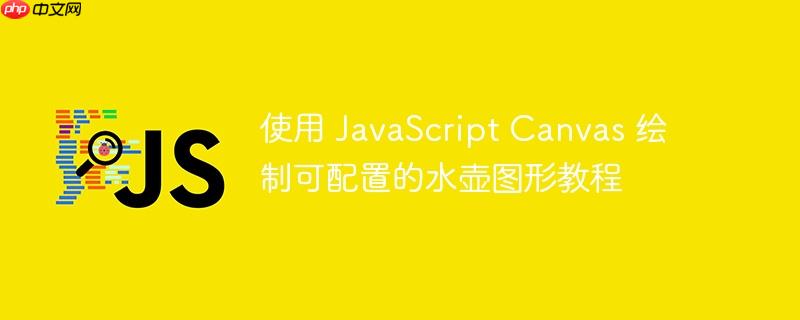
在 html <canvas> 元素上绘制图形,核心在于使用其 2d 渲染上下文(canvasrenderingcontext2d)提供的路径方法。绘制复杂图形通常涉及以下步骤:
在绘制复杂图形时,一个常见的陷阱是忘记调用 ctx.beginPath(),或者在不恰当的位置使用 ctx.moveTo(),导致路径连接混乱。
最初的绘制代码将所有坐标硬编码,导致图形无法在 Canvas 的不同位置重复绘制,也难以调整大小。为了解决这个问题,最佳实践是将绘制逻辑封装到一个函数中,并传入图形的起始坐标 (x, y) 作为参数。这样,所有内部的坐标都将基于这个 (x, y) 进行相对偏移。
const ctx = document.getElementById('view').getContext('2d');
/**
* 绘制一个水壶图形
* @param {CanvasRenderingContext2D} ctx - Canvas 2D 渲染上下文
* @param {number} x - 水壶的起始X坐标
* @param {number} y - 水壶的起始Y坐标
*/
const drawJug = (ctx, x, y) => {
ctx.beginPath(); // 开始新的路径
// 壶口部分
ctx.moveTo(x, y); // 左上角起点
ctx.quadraticCurveTo(x + 50, y - 40, x + 100, y); // 壶口向上弯曲
ctx.quadraticCurveTo(x + 50, y + 40, x, y); // 壶口向下弯曲,形成椭圆
// 壶身左侧
ctx.bezierCurveTo(x + 10, y + 50, x - 10, y + 60, x, y + 100);
// 壶身右侧 (重要:这里需要一个新的 moveTo,因为右侧路径不与左侧路径直接相连)
// 原始问题中,此处的 moveTo(205, 105) 是硬编码的,没有相对起始点 x,y,导致连接错误。
// 正确的做法是基于 x,y 偏移,例如 moveTo(x + 100, y)。
ctx.moveTo(x + 100, y);
ctx.bezierCurveTo(x + 70, y + 50, x + 110, y + 40, x + 105, y + 100);
// 壶底
ctx.quadraticCurveTo(x + 52.5, y + 140, x, y + 100);
// 壶柄
ctx.moveTo(x, y + 65); // 壶柄起点,需要一个新的 moveTo
ctx.arc(x, y + 40, 25, 0.5 * Math.PI, 1.55 * Math.PI);
// 壶内液体(可选)
ctx.moveTo(x, y + 50); // 液体起点
ctx.quadraticCurveTo(x + 52.5, y + 20, x + 95, y + 50); // 液体向上弯曲
ctx.quadraticCurveTo(x + 52.5, y + 70, x, y + 50); // 液体向下弯曲
ctx.stroke(); // 描边绘制路径
};
// 主绘制函数
const main = () => {
// 优化线条清晰度,通过将坐标偏移 0.5 像素来对齐像素网格
ctx.translate(0.5, 0.5);
// 填充背景
ctx.fillStyle = '#000';
ctx.fillRect(0, 0, ctx.canvas.width, ctx.canvas.height);
// 绘制不同位置和颜色的水壶
ctx.strokeStyle = 'hsl(0, 100%, 75%)'; // 红色
drawJug(ctx, 50, 40);
ctx.strokeStyle = 'hsl(120, 100%, 75%)'; // 绿色
drawJug(ctx, 200, 40);
ctx.strokeStyle = 'hsl(180, 100%, 75%)'; // 青色
drawJug(ctx, 350, 40);
};
main(); // 执行主绘制函数代码解析与改进点:
为了让水壶的绘制更加灵活,我们可以引入更多的参数来控制其宽度、高度以及各个部分的具体样式,如壶口大小、壶底弧度、水面高度和壶柄半径等。
立即学习“Java免费学习笔记(深入)”;
const ctx = document.getElementById('view').getContext('2d');
// 默认配置选项
const defaultOptions = {
mouth: 0, // 壶口弧度深度
bottom: 0, // 壶底弧度深度
water: 0, // 水面弧度深度
handleRadius: 0 // 壶柄半径
};
/**
* 绘制一个可配置的水壶图形
* @param {CanvasRenderingContext2D} ctx - Canvas 2D 渲染上下文
* @param {number} x - 水壶的起始X坐标(左上角)
* @param {number} y - 水壶的起始Y坐标(左上角)
* @param {number} width - 水壶的宽度
* @param {number} height - 水壶的高度
* @param {object} options - 配置选项,如 { mouth, bottom, water, handleRadius }
*/
const drawJug = (ctx, x, y, width, height, options) => {
const opts = { ...defaultOptions, ...options }; // 合并默认选项与传入选项
ctx.beginPath(); // 开始新的路径
// 壶口部分
ctx.moveTo(x, y);
ctx.quadraticCurveTo(x + (width / 2), y - opts.mouth, x + width, y); // 壶口向上弯曲
ctx.quadraticCurveTo(x + (width / 2), y + opts.mouth, x, y); // 壶口向下弯曲
// 壶身左侧
ctx.bezierCurveTo(x + 10, y + (height / 2), x - 10, y + (height / 2) + 10, x, y + height);
// 壶身右侧
ctx.moveTo(x + width, y); // 移动到壶口右侧起点
ctx.bezierCurveTo(x + (width / 2) + 20, y + (height / 2), x + width + 10, y + (height / 2) - 10, x + width + 5, y + height);
// 壶底
ctx.quadraticCurveTo(x + (width / 2) + 2.5, y + height + opts.bottom, x, y + height);
// 壶柄
ctx.moveTo(x, y + (height / 2) + (opts.handleRadius / 2));
ctx.arc(x, y + (height / 2) - 10, opts.handleRadius, 0.5 * Math.PI, 1.55 * Math.PI);
// 壶内液体
ctx.moveTo(x, y + (height / 2));
ctx.quadraticCurveTo(x + (width / 2) + 2.5, y + (height / 2) - opts.water, x + width - 5, y + (height / 2));
ctx.quadraticCurveTo(x + (width / 2) + 2.5, y + (height / 2) + opts.water, x, y + (height / 2));
ctx.stroke(); // 描边绘制路径
};
// 主绘制函数
const main = () => {
ctx.translate(0.5, 0.5); // 优化线条清晰度
ctx.fillStyle = '#000';
ctx.fillRect(0, 0, ctx.canvas.width, ctx.canvas.height);
// 绘制第一个水壶:红色,标准尺寸,默认配置
ctx.strokeStyle = 'hsl(0, 100%, 75%)';
drawJug(ctx, 50, 40, 100, 100, {
mouth: 40,
bottom: 40,
water: 20,
handleRadius: 25
});
// 绘制第二个水壶:绿色,不同高度和壶口尺寸
ctx.strokeStyle = 'hsl(120, 100%, 75%)';
drawJug(ctx, 200, 50, 100, 80, {
mouth: 30,
bottom: 40,
water: 15,
handleRadius: 25
});
// 绘制第三个水壶:青色,不同宽度和壶底尺寸
ctx.strokeStyle = 'hsl(180, 100%, 75%)';
drawJug(ctx, 350, 40, 80, 100, {
mouth: 20,
bottom: 30,
water: 20,
handleRadius: 25
});
};
main(); // 执行主绘制函数HTML 结构:
为了运行上述 JavaScript 代码,你需要一个 HTML 文件,其中包含一个 <canvas> 元素。
<!DOCTYPE html>
<html lang="zh-CN">
<head>
<meta charset="UTF-8">
<meta name="viewport" content="width=device-width, initial-scale=1.0">
<title>Canvas 绘制水壶</title>
<style>
/* 简单的 CSS 样式,用于居中 Canvas */
html, body {
width: 100%;
height: 100%;
margin: 0;
padding: 0;
display: flex;
align-items: center;
justify-content: center;
background: #222; /* 深色背景,突出显示图形 */
}
canvas {
border: 1px solid #555; /* 给 Canvas 添加边框以便观察 */
}
</style>
</head>
<body>
<canvas id="view" width="500" height="180"></canvas>
<script src="your_script_name.js"></script> <!-- 确保脚本文件路径正确 -->
</body>
</html>将上述 JavaScript 代码保存为 your_script_name.js(例如 jug_drawing.js),并确保 HTML 文件中的 <script> 标签指向正确的文件名。
通过本教程,您应该能够掌握使用 JavaScript Canvas 绘制复杂且可配置图形的方法,并将其应用于更广泛的交互式图形和数据可视化项目中。
以上就是使用 JavaScript Canvas 绘制可配置的水壶图形教程的详细内容,更多请关注php中文网其它相关文章!

每个人都需要一台速度更快、更稳定的 PC。随着时间的推移,垃圾文件、旧注册表数据和不必要的后台进程会占用资源并降低性能。幸运的是,许多工具可以让 Windows 保持平稳运行。

Copyright 2014-2025 https://www.php.cn/ All Rights Reserved | php.cn | 湘ICP备2023035733号